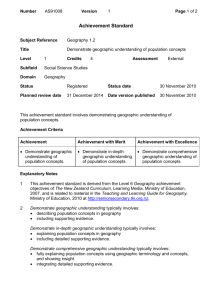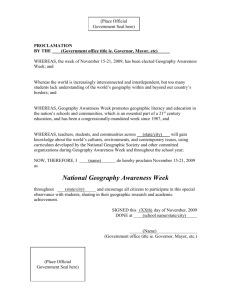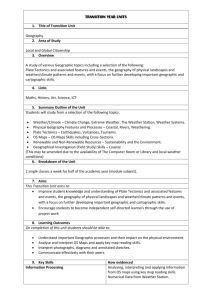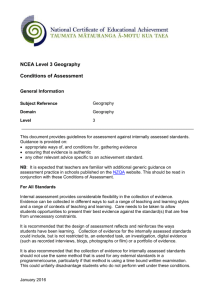Level 3 Geography internal assessment resource
advertisement
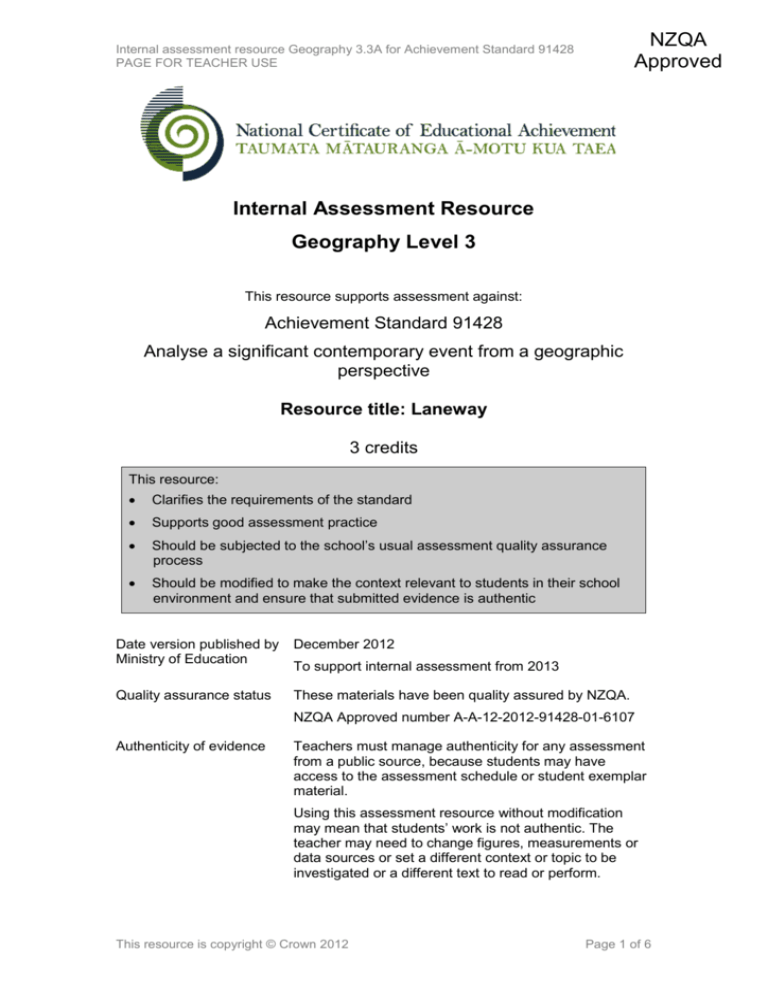
NZQA Approved Internal assessment resource Geography 3.3A for Achievement Standard 91428 PAGE FOR TEACHER USE Internal Assessment Resource Geography Level 3 This resource supports assessment against: Achievement Standard 91428 Analyse a significant contemporary event from a geographic perspective Resource title: Laneway 3 credits This resource: Clarifies the requirements of the standard Supports good assessment practice Should be subjected to the school’s usual assessment quality assurance process Should be modified to make the context relevant to students in their school environment and ensure that submitted evidence is authentic Date version published by Ministry of Education December 2012 Quality assurance status These materials have been quality assured by NZQA. To support internal assessment from 2013 NZQA Approved number A-A-12-2012-91428-01-6107 Authenticity of evidence Teachers must manage authenticity for any assessment from a public source, because students may have access to the assessment schedule or student exemplar material. Using this assessment resource without modification may mean that students’ work is not authentic. The teacher may need to change figures, measurements or data sources or set a different context or topic to be investigated or a different text to read or perform. This resource is copyright © Crown 2012 Page 1 of 6 Internal assessment resource Geography 3.3A for Achievement Standard 91428 PAGE FOR TEACHER USE Internal Assessment Resource Achievement Standard Geography 91428: Analyse a significant contemporary event from a geographic perspective Resource reference: Geography 3.3A Resource title: Laneway Credits: 3 Teacher guidelines The following guidelines are supplied to enable teachers to carry out valid and consistent assessment using this internal assessment resource. Teachers need to be very familiar with the outcome being assessed by Achievement Standard Geography 91428. The achievement criteria and the explanatory notes contain information, definitions, and requirements that are crucial when interpreting the standard and assessing students against it. Context/setting This assessment activity requires students to analyse the planning, decision-making, and the social, economic and/or environmental impacts of an event such as St Jerome’s Laneway Festival. Conditions This is an individual assessment activity to be completed over three weeks of in-class and out-of-class time. Resource requirements Information on the Laneway Festival: social media sites such as Facebook news websites. You need to gather information from past and upcoming festivals. Resources may include newspaper articles, interviews, and press releases. Information related to the specific local authority plans is required. Additional information None. This resource is copyright © Crown 2012 Page 2 of 6 Internal assessment resource Geography 3.3A for Achievement Standard 91428 PAGE FOR STUDENT USE Internal Assessment Resource Achievement Standard Geography 91428: Analyse a significant contemporary event from a geographic perspective Resource reference: Geography 3.3A Resource title: Laneway Credits: 3 Achievement Analyse a significant contemporary event from a geographic perspective. Achievement with Merit Analyse, in depth, a significant contemporary event from a geographic perspective. Achievement with Excellence Analyse comprehensively a significant contemporary event from a geographic perspective. Student instructions Introduction The St Jerome’s Laneway Festival is a one-day music festival that takes place in various cities throughout Australasia including Auckland. This assessment activity requires you to analyse the planning, decision-making and social, economic and/or environmental impacts of the Laneway Festival in Auckland. You may present your analysis in a number of different ways: for example, as a video or podcast documentary, a written report, a computer-aided presentation (with attached explanatory notes), or a combination of these. You will complete this assessment task individually, over three weeks of in-class and out-of-class time. You will be assessed on the comprehensiveness of your analysis. Task Produce, on behalf of the local ratepayers of Auckland city, a report analysing the festival from a geographic perspective. In your report: outline the nature of this contemporary event by commenting on: – the purpose and significance of the event – the spatial nature of the event – specific features or characteristics of the event – how the event shows interaction between people and the environment explain in detail and evaluate the planning and decision-making involved in the event (refer to further guidance below) explain in detail and evaluate the social, economic, and/or environmental impacts of the event. This may include positive/negative and short/long-term impacts (refer to further guidance below). This resource is copyright © Crown 2012 Page 3 of 6 Internal assessment resource Geography 3.3A for Achievement Standard 91428 PAGE FOR STUDENT USE Throughout your answers, use appropriate geographic terminology and concepts. All work must be in your own words. Ensure that you use a variety of resources and cite any sources/references in a bibliography. You may use annotated visual media, such as maps, diagrams, or photos within your report. Further guidance Your teacher will provide some information about the planning, decision-making, and impacts related to the festival. You will have time in class to discuss this information and to make notes. This may include: why the site was chosen identification of the authority empowered to make the final decision a flow diagram outlining the planning process a description of supporting data and other relevant information that would be of assistance to the organisers of the event a discussion about any consents that were required before the festival could occur identification of the procedures for notifying the public and/or identifying and consulting with affected parties how the event organisers dealt with any special conditions imposed by other agents, for example, council or police an explanation of how the final decision was arrived at. This might include, for example, how people’s values, beliefs, and perspectives influenced decisionmaking processes or how various methodology was used, such as: – Social Cost Benefit Analysis – Environmental Impact Assessment – Goals Achievement Analysis – Sieve Analysis. An evaluation requires an assessment or judgement of: the planning and decision-making that was involved in the event, which could include a discussion of the effectiveness (strengths and/or weaknesses) of the components explained. The evaluation builds on the detailed explanation of the planning and decision-making process involved. the social, economic and/or environmental impacts of the event, which could include a discussion of the significance of the impact or a comparison of the levels of impact the event has on each aspect. The evaluation builds on the detailed explanation of the impacts of the event. This resource is copyright © Crown 2012 Page 4 of 6 Internal assessment resource Geography 3.3A for Achievement Standard 91428 PAGE FOR TEACHER USE Assessment schedule: Geography 91428 Laneway Evidence/Judgements for Achievement Evidence/Judgements for Achievement with Merit Evidence/Judgements for Achievement with Excellence The student analyses a significant contemporary event from a geographic perspective. This means that the student: The student analyses, in depth, a significant contemporary event from a geographic perspective. This means that the student: The student analyses comprehensively a significant contemporary event from a geographic perspective. This means that the student: outlines the nature of the festival from a geographic perspective, such as the spatial nature of the event, interaction between people and the environment, and characteristics of the natural and/or cultural features that make up the event outlines the nature of the festival from a geographic perspective, such as the spatial nature of the event, interaction between people and the environment, and characteristics of the natural and/or cultural features that make up the event outlines the nature of the festival from a geographic perspective, such as the spatial nature of the event, interaction between people and the environment, and characteristics of the natural and/or cultural features that make up the event explains the planning and decision-making process involved in the event explains in detail the planning and decisionmaking involved in the event identifies and explains the social, economic and/or environmental impacts of the event uses geographic terminology and concepts supports their analysis with relevant evidence. This may include visual material such as diagrams, graphs, tables, and other appropriate visual media. explains in detail the social, economic and/or environmental impacts of the event. These could include both positive and/or negative impacts uses appropriate geographic terminology and concepts explains in detail and evaluates the planning and decision-making involved in the event. The evaluation must indicate the effectiveness of the components of the planning and decisionmaking. This may, for example, include how people’s values, perceptions, and perspectives influenced decision-making processes or how various methodology was used such as: supports their in-depth analysis with relevant detailed evidence that may include visual material such as diagrams, graphs, tables, and other appropriate visual media. For example [partial extract]: Physical Environment There are several impacts on the physical environment. These include noise pollution, litter, managing waste at the venue, etc. On the day of the festival, people will generate a huge amount of waste. This waste is from the packaging of their food and drink, as well as human waste. It is important that the organisers take this waste generation into account when planning the event. The examples above relate to only part of what is required, and are just indicative. This resource is copyright © Crown 2012 For example [partial extract]: – Social Cost Benefit Analysis – Environmental Impact Assessment – Goals Achievement Analysis – Sieve Analysis explains in detail and evaluates social, economic and/or environmental impacts of this event. This could include a discussion of both positive and/or negative impacts. The evaluation should include a judgement as to the significance of the impact or comparison of the level of impact the event has on the different aspects. consistently uses appropriate geographic terminology and concepts throughout their Physical Environment There are several impacts on the physical environment. These can be both positive and negative impacts. For example, the negative impacts on the physical environment include noise pollution, visual pollution, litter, managing waste at the venue etc. On the day of the festival, people will generate a huge amount of waste. This waste is from the packaging of their food and drink, as Page 5 of 6 Internal assessment resource Geography 3.3A for Achievement Standard 91428 PAGE FOR TEACHER USE well as human waste. It is important that the organisers take this waste generation into account when planning the event. For example, the organisers should provide waste disposal, including recycling bins on site. There should be porta-loos provided. Both these means of collecting waste should be regularly emptied to maintain a clean and safe environment and to decrease any negative impacts on the physical environment. The examples above relate to only part of what is required, and are just indicative. analysis supports their comprehensive analysis and evaluation with a range of relevant detailed evidence, that may include diagrams, graphs, tables, and other appropriate visual media. Their significance is explained. Concepts may include how people’s values, perceptions, and perspectives influence decisionmaking processes. The student shows an understanding of the concept that there is an interaction of all anticipated impacts of the event and that this is a fundamental part of planning and decision-making. For example [partial extract]: Physical Environment There are several impacts on the physical environment from the festival. These include: waste generation (including food and drink packaging and human waste), noise and visual pollution (including litter, billboards, staging. These impacts may be positive and/or negative. Often the resulting impact will depend on how it is managed. There are legislative controls that limit the most obvious forms of noise and visual pollution and special applications must be made to the council… The examples above relate to only part of what is required, and are just indicative. Final grades will be decided using professional judgement based on a holistic examination of the evidence provided against the criteria in the Achievement Standard. This resource is copyright © Crown 2012 Page 6 of 6




